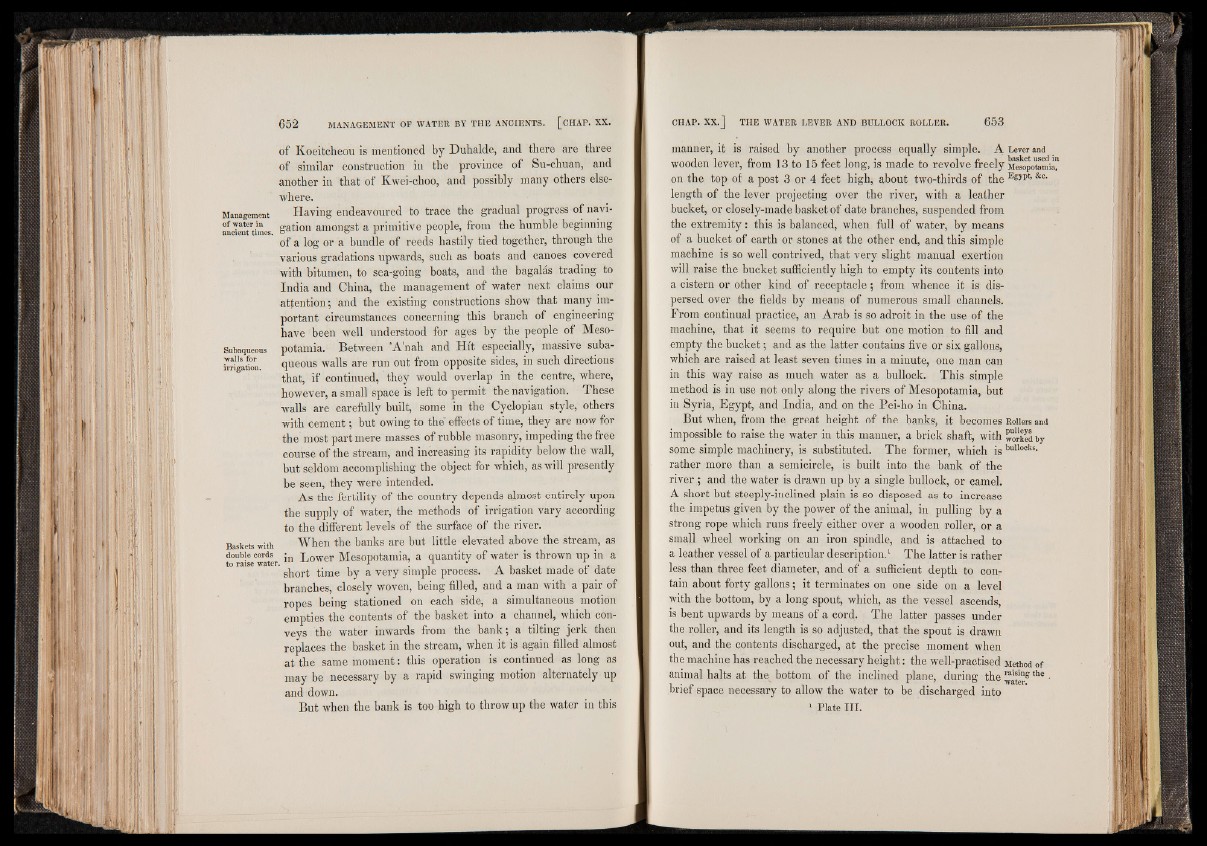
Management
of water in
ancient times.
Subaqueous
walls for
irrigation.
of Koeitcheou is mentioned by Dubalde, and there are three
of similar construction in the province of Su-chuan, and
another in that of Kwei-choo, and possibly many others elsewhere.
Having endeavoured to trace the gradual progress of navigation
Baskets with
double cords
to raise water.
amongst a primitive people, from the humble beginning
of a log or a bundle of reeds hastily tied together, through the
various gradations upwards, such as boats and canoes covered
with bitumen, to sea-going boats, and the bagalas trading to
India and China, the management of water next claims our
attention; and the existing constructions show that many important
circumstances concerning this branch of engineering
have been well understood for ages by the people of Mesopotamia.
Between ’A'nah and Hit especially, massive subaqueous
walls are run out from opposite sides, in such directions
that, if continued, they would overlap in the centre, where,
however, a small space is left to permit the navigation. These
walls are carefiilly built, some in the Cyclopian style, others
with cement; but owing to the' effects of time, they are now for
the most part mere masses of rubble masonry, impeding the free
course of the stream, and increasing its rapidity below the wall,
hut seldom accomplishing the object for which, as will presently
be seen, they were intended.
As the fertility of the country depends almost entirely upon
the supply of water, the methods of irrigation vary according
to the different levels of the surface of the river.
When the banks are but little elevated above the stream, as
in Lower Mesopotamia, a quantity of water is thrown up in a
short time by a very simple process. A basket made of date
branches, closely woven, being filled, and a man with a pair of
ropes being stationed on each side, a simultaneous motion
empties the contents of the basket into a channel, which conveys
the water inwards from the bank; a tilting jerk then
replaces the basket in the stream, when it is again filled almost
at the same moment: this operation is continued as long as
may be necessary by a rapid swinging motion alternately up
and down.
But when the bank is too high to throw up the water in this
manner, it is raised by another process equally simple. A Lever and
wooden lever, from 13 to 15 feet long, is made to revolve freely Mesopotamia^
on the top of a post 3 or 4 feet high, about two-thirds of the &c-
length of the lever projecting over the river, with a leather
bucket, or closely-made basket of date branches, suspended from
the extremity: this is balanced, when full of water, by means
of a bucket of earth or stones at the other end, and this simple
machine is so well contrived, that very slight manual exertion
will raise the bucket sufficiently high to empty its contents into
a cistern or other kind of receptacle; from whence it is dispersed
over the fields by means of numerous small channels.
From continual practice, an Arab is so adroit in the use of the
machine, that it seems to require but one motion to fill and
empty the bucket; and as the latter contains five or six gallons,
which are raised at least seven times in a minute, one man can
in this way raise as much water as a bullock. This simple
method is in use not only along the rivers of Mesopotamia, but
in Syria, Egypt, and India, and on the Pei-ho in China.
But when, from the great height of the banks, it becomes Rollers and
impossible to raise the water in this manner, a brick shaft, with worked by
some simple machinery, is substituted. The former, which is bullocks-
rather more than a semicircle, is built into the bank of the
river ; and the water is drawn up by a single bullock, or camel.
A short but steeply-inclined plain is so disposed as to increase
the impetus given by the power of the animal, in pulling by a
strong rope which runs freely either over a wooden roller, or a
small wheel working on an iron spindle, and is attached to
a leather vessel of a particular description.1 The latter is rather
less than three feet diameter, and of a sufficient depth to contain
about forty gallons; it terminates on one side on a level
with the bottom, by a long spout, which, as the vessel ascends,
is bent upwards by means of a cord. The latter passes under
the roller, and its length is so adjusted, that the spout is drawn
out, and the contents discharged, at the precise moment when
the machine has reached the necessary height: the well-practised Method of
animal halts at thev bottom of the inclined plane, during the wlf“8 the •
brief space necessary to allow the water to be discharged into
1 Plate I I I .